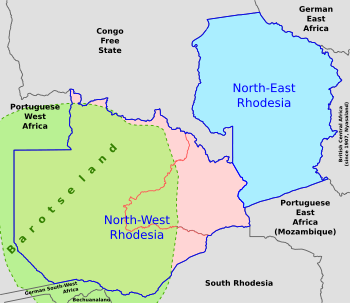Barotziland–North-Western Rhodesia facts for kids
Quick facts for kids
Barotziland–North-Western Rhodesia
|
|||||||||
|---|---|---|---|---|---|---|---|---|---|
| 1899–1911 | |||||||||
|
Anthem: "God save the King/Queen"
|
|||||||||

south-central Africa, 1899–1911; North-Western Rhodesia is shaded red.
|
|||||||||
| Capital | Kalomo (1899-1907), Livingstone (1907-1911) | ||||||||
| Common languages | English (official) Nyanja, Bemba, Tonga and Lozi widely spoken |
||||||||
| Government | Colonial administration | ||||||||
| Monarch | |||||||||
|
• 1899–1901
|
Victoria | ||||||||
|
• 1901–1910
|
Edward VII | ||||||||
|
• 1910-1911
|
George V | ||||||||
| Administrator | |||||||||
|
• 1900–1907 (first)
|
Robert Thorne Coryndon | ||||||||
|
• 1907-1908
|
Robert Edward Codrington | ||||||||
|
• 1909-1911 (last)
|
Lawrence Aubrey Wallace | ||||||||
| Historical era | late 19th & early 20th centuries | ||||||||
|
• Established
|
28 November 1899 | ||||||||
|
• Amalgamated with North-Eastern Rhodesia as Northern Rhodesia
|
17 August 1911 |
||||||||
| Area | |||||||||
|
• Total
|
182,000 sq mi (470,000 km2) | ||||||||
| Population | |||||||||
|
• Estimate
|
7 | ||||||||
| Currency | Southern Rhodesian pound | ||||||||
|
|||||||||
| Today part of | Zambia | ||||||||
Barotziland–North-Western Rhodesia was a British protectorate in south-central Africa. It was formed in 1899. A protectorate is a country that is protected and partly controlled by a stronger country. This area included two regions: North-Western Rhodesia and Barotseland.
The British South Africa Company managed this protectorate. It was the largest of three areas often called the Rhodesian protectorates. The other two were Southern Rhodesia and North-Eastern Rhodesia. In 1911, Barotziland–North-Western Rhodesia joined with North-Eastern Rhodesia. Together, they formed a new territory called Northern Rhodesia. Today, this area is part of Zambia.
Contents
History
How it Started
In 1890, a powerful leader named King Lewanika ruled the Barotse people. He was worried about attacks from the Portuguese (in Angola to the west) and from the Ndebele people (Matabele) to the east. Because of this, King Lewanika wanted British protection.
He signed a treaty with the British South Africa Company. This company was a powerful British business. The treaty gave the company rights to minerals and trade in the Barotse territory. It also offered protection to King Lewanika. However, only the British government could officially make the territory a protectorate.
British Control Begins
In 1897, Robert Coryndon was sent to Barotseland. He worked for Cecil Rhodes, who was in charge of the British South Africa Company. Coryndon was meant to represent the company there. When he arrived at King Lewanika's capital, Lealui, the King was not very welcoming. King Lewanika found it hard to believe that Coryndon could represent both the company and the British government.
However, in November 1899, Queen Victoria of the United Kingdom signed an important document. It was called the Barotziland–North Western Rhodesia Order in Council, 1899. This document officially combined North-Western Rhodesia with Barotseland. It also made the entire area a protectorate named Barotziland–North-Western Rhodesia. King Lewanika was happy about this official protectorate status.
How the Protectorate Was Run
The new protectorate was managed by an Administrator. This person was chosen by the High Commissioner for South Africa. The High Commissioner was a top British official. The Administrator helped govern the area. The protectorate was divided into nine smaller districts for easier management.
In September 1900, Robert Coryndon became the first Administrator. He held this job until 1907. After him, Robert Edward Codrington took over, but he passed away within a year. The last Administrator was Lawrence Aubrey Wallace. The first capital city was Kalomo. In 1907, the capital moved to Livingstone.
In 1911, Barotziland–North-Western Rhodesia joined with North-Eastern Rhodesia. They formed a new, larger territory called Northern Rhodesia. The Administrator of Northern Rhodesia then took over the duties of the previous Administrator.
Laws and Justice
The laws of England were used in the protectorate. However, they were adjusted to fit local conditions. When there were disagreements between local people, their traditional laws and customs were usually followed. This was true unless these customs went against the British King's power.
The High Commissioner had the power to set up the justice system. An Administrator's Court was created with three judges. The Administrator was the head judge. Smaller Magistrates' Courts were also set up. Decisions from these courts could be appealed to the Administrator's Court. If someone still disagreed, they could appeal to the Supreme Court of the Cape Colony (another British territory). Finally, they could even appeal to the Privy Council in the United Kingdom.
See also
- British South Africa Company
- Company rule in Rhodesia
- Rhodesia (name)
- Northern Rhodesia


